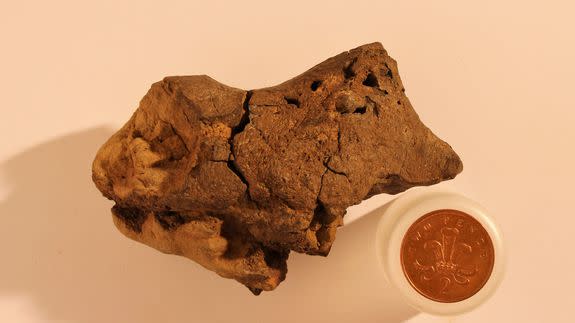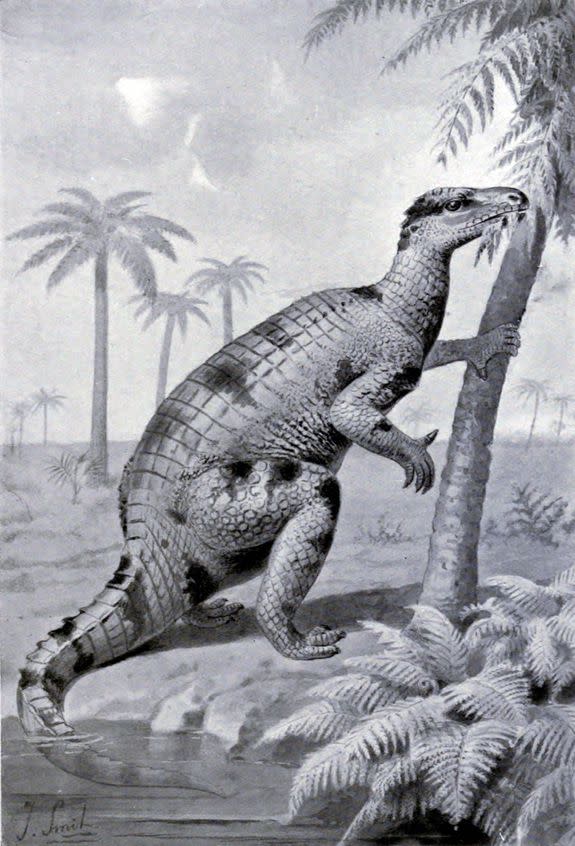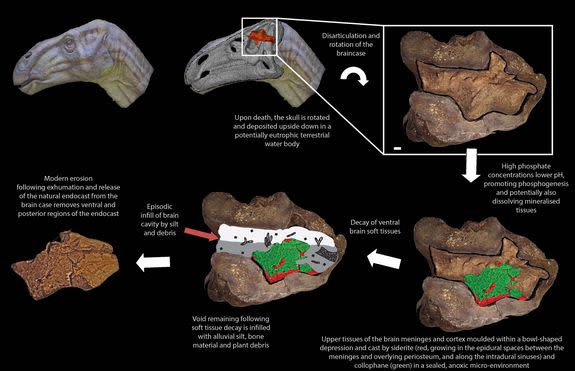The first fossilized dinosaur brain was just identified in England

In the ancient swamps of southeast England, a palm-sized clump lay pickling in river sediment for 133 million years. Then a fossil hunter found the stone in 2004.
Scientists have now determined the clump was actually the fossilized brain tissue of a large leaf-eating dinosaur, possibly from a species similar to the Iguanodon.
The specimen is the world's first known example of dinosaur brain tissue, according to a special publication by the Geological Society of London released Thursday.
SEE ALSO: Paleontologists just found a 2,500-pound T. rex skull in Montana
The dinosaur fossil shows distinct similarities to the brains of modern-day crocodiles and birds, the scientists found.
The discovery may shed light on how the brains of dinosaurs and other ancient creatures evolved over millions of years, an area that has long stumped researchers.
Brain tissue, unlike durable bones and teeth, is often one of the first parts of the body to decay.
The finding could also help other paleontologists to spot more fossilized dinosaur brains, now that they know to look for clues in unassuming clumps of dirt, said Lawrence Witmer, a professor of anatomy at Ohio University's Heritage College of Osteopathic Medicine, who was not involved with the new research.

Image: biodiversity heritage library/wikimedia commons
"This changes our 'search image.' It tells us what we should be looking for," Witmer told Mashable.
"To have potentially some of those tissues preserved is truly remarkable," he said.
Dino discovery
Fossil hunter Jamie Hiscocks first found the fossilized brain in 2004 while digging near Bexhill, a seaside town in England's rural Sussex County.
He turned the specimen over to Martin Brasier from the University of Oxford and David Norman from the University of Cambridge, who soon began coordinating research into the fossil. After Brasier died in a traffic accident in 2014, Norman continued the work with other researchers.
The British scientists said this particular brain fossil likely survived because the dinosaur died in a bog or swamp, where highly acidic and low-oxygen water helped to mineralize and preserve parts of the brain.
Working with colleagues from the University of Western Australia, the team used scanning electron microscope (SEM) techniques to identify two key parts of the fossilized brain: the meninges — the tough, outer membranes that surround the brain itself — and the neural tissue beneath it, which includes strands of collagen and blood vessels.
The outer membrane was the best-preserved part of the fossil. But the researchers were somewhat more cautious about interpreting the softer material they believe to be brain tissue.
Structures that could represent tissues from the brain cortex — the outer layer of neural tissue — appear to be present and interwoven with delicate capillaries, the authors said in Thursday's publication.
They also hesitated to draw conclusions about the intelligence of dinosaurs from this particular fossil.

Image: UNIVERSITY OF CAMBRIDGE
The Iguanodon lived during the early Cretaceous Period, could walk on two feet or all fours and had large thumb spikes that may have been used to fend off predators. It was the first identified dinosaur species more than 150 years ago.
In typical reptiles, the sausage-shaped brain takes up only about half the space within a cranial cavity. The tissue of this dinosaur's fossilized brain appeared to have been pressed directly against its skull, which could mean it had a large brain that filled the entire cavity. This also may have resulted from decay over time, since gravity could have caused it to collapse and press against the cavity's bony roof.
"It's entirely possible that dinosaurs had bigger brains that we give them credit for, but we can't tell from this specimen alone," Norman, the British paleontologist at Cambridge, said in a statement.
"What's truly remarkable is that conditions were just right in order to allow preservation of the brain tissue," he added.
